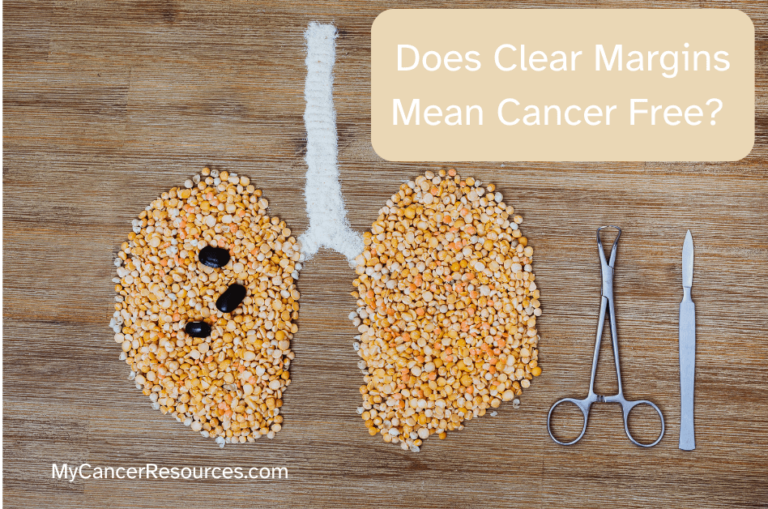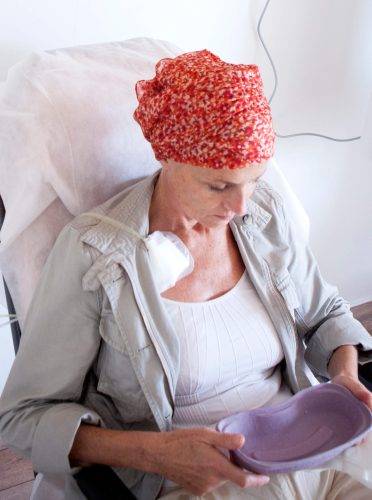
One of the first questions people with cancer and their caregivers ask the doctors after surgery to remove a cancerous tumor is, “Did they get it all?”
Since the purpose of the surgery is to remove the tumor, it’s common to wonder if all tumor cells were removed from their body. In these scenarios, doctors often talk about ‘clear margins.’
A ‘margin’ refers to the edge of the tissue removed during surgery. When a report comes back saying those margins are ‘clear,’ it means the surgeons didn’t find any cancer cells in those edge areas. It’s a good sign, indicating they likely removed all the tissue that was cancerous.
But, clear margins do not always mean you are cancer free. Instead, consider clear margins as a step toward recovery, ensuring a more targeted approach for any further treatment. So, in simple terms, clear margins are like the first big win in a series of approaches to defeat cancer.
Understanding Surgical Margins
In cancer surgery, surgeons will not only remove the visible tumor, but they’ll also remove a border of tissue surrounding the edges of the tumor that can be seen.
Remember cancer cells start out small and continue to grow. This means that there may be cancerous cells beyond the group of cells that have formed the tumor.
So doctors want to remove a little bit more around the tumor itself in hopes of catching all cancer cells. In other words, it’s like a buffer zone, the space between the edge of the tissue they removed and where the tumor was located.
It’s a delicate balance, especially in the case of a breast tumor. If there is too little tissue taken, some cancer might remain. If there’s too much removed, the appearance of your breast changes more than necessary. Breast cancer surgery aims for that sweet spot, where the cancer is gone but your breast looks and feels as natural as can be.
When the surgery is over, the extra tissue that was removed is sent to a pathologist, a specialized doctor who looks at the cells underneath a microscope. They determine if those tissues have cancer cells lurking in them.
The pathology report that is written after the pathologist has reviewed all tissue will likely have one of the following comments about the margins that were evaluated:
- Positive margins: This means that cancer cells are present in the tissue. It may indicate that some cancerous tissue around the tumor might have been missed.
- Close margins: This means it could go either way. It looks like everything was removed, but there may be reasons for doctors to remain concerned that cancer cells may still be in nearby tissue.
- Negative margins, clean margins or clear margins: This is the response we’re hoping for. It means the tumor was removed, and the edges of the removed tissue tissue are nice and healthy, with no cancer cells seen at all.
Does Clear Margins Mean Cancer Free?
Hearing your healthcare provider say ‘you have clear margins’ can feel like a huge relief and certainly be cause for celebration! (I am all about celebrating wins against cancer, no matter how big or small!)
Free margins means the surgeons removed the tumor along with a rim of normal tissue around it, all clear of cancer cells. But does this guarantee you’re completely cancer-free? Not exactly.
Clear margins are a pivotal goal in surgeries like lumpectomy for breast cancer or wide local excision for melanoma. They reduce the risk of cancer hiding in the surrounding tissue. But, there’s more to the story.
Cancer treatments, including surgery, aim for the best outcome. For types of breast cancer, lung cancer and skin cancers, among others, clear margins decrease the need for a second surgery and lower the chance of cancer returning.
Having clear margins are an important victory. But they’re part of a broader strategy. Your medical team may recommend a ‘watch and see’ approach, meaning you’ll return for bloodwork and scans on a regular basis so they can see if there are any indications that the cancer has returned.
Or your medical team may also recommend additional treatments like chemotherapy, radiation therapy, or hormone therapy even after achieving clear margins. Think of these additional treatments as a clean-up crew.
Chemotherapy cleans up cells hiding in all corners of your body. Radiation treatments zero in on the tissue surrounding where the tumor was, killing off remaining cancer cells that could cause problems later.
Hormone therapy works a bit differently. Some cancers grow because of hormones in your body. This therapy uses medication to block those hormones, essentially starving the cancer cells and preventing them from growing back. It’s like cutting off the fuel supply to ensure the cancer can’t make a comeback.
Whatever method is recommended and you choose to use, these strategies ensure the highest chances of eliminating cancer cells that might remain unseen.
Remember, a clear margin status significantly boosts the effectiveness of your treatment plan, but doesn’t always signal the end of the road.
Recent Advances
Groundbreaking advances have been seen in recent years, changing how cancer surgery is approached. Way back in the day, it used to be if a sarcoma tumor was discovered in the leg, the entire leg was amputated.
Now surgeons and medical teams use techniques that seemed like mere dreams just a decade ago.
New methods make surgeries more precise, focusing on removing cancerous tissue and preserving as much healthy tissue as possible.
This has not only improved the quality of life for many, but also significantly reduced the need for additional surgery. These methods marks a promising shift in ensuring patients stand a better chance at a cancer-free diagnosis.
New guidelines on the definition of a negative margin have emerged, guided by insights from extensive research and clinical trials.
There’s now a scientifically-backed push toward narrower margins that still qualify as clean, reducing the need for further operations while maintaining high standards of patient care.
Equally important has been the improvement in radiation therapy techniques, focusing in on a smaller area while providing targeted treatment of the affected area of the body.
Surgery and radiation therapy can be a good tag-team in the quest for clear margins. Together, these advances ensure not just the removal of the primary tumor but also help protect the surrounding area against a local recurrence of cancer.
Navigating the Journey Ahead
The cancer journey is often filled with more questions than answers. But now you know the answer to the question “Does clear margins mean cancer free?
The term ‘clear margins’ can bring a sigh of relief, and it is certainly cause to celebrate that the tumor has been removed and nearby cells show no cancer.
It’s also important to remember, however; that clear margins don’t always signal that it’s the end of the road. Breast cancer, prostate cancer, non-small cell lung cancer – the type of cancer doesn’t change the need for vigilance.
This is also where it becomes crucial to understand the difference between clear, positive, and close margins. Each term can signal a different path to follow.
Clear and negative margins might mean no remaining visible cancer cells at the surgery’s edge, which may lead your health care providers to recommend a watch and see approach.
Positive or close margins suggest some cancerous cells might still linger. This can lead to recommendations by your healthcare team for another surgical procedure to get wider margins (remove more tissue from around the tumor site) or treatments like radiation or hormone therapy.
Keeping a close eye on the original tumor site or having additional treatments or surgery are all options to consider in consultation with your medical care team.
Your medical team will decipher pathology reports, and lean on their knowledge about your specific type of cancer and local recurrence rates. This is the rate at how often tumors come back in that same area where one was before.
Your medical team will explain additional treatments options for you to consider, along with the impact each option would have on your quality of life. Remember, you are the most crucial member of this team.
Voicing your concerns, asking about every treatment option, and understanding their side effects empowers you and can help you make the decision that’s best for you. It’s about more than just survival – it’s also about living well and on your terms.
Throughout it all, clear communication with your healthcare provider remains key. They can offer insights into everything from managing pain medication to navigating the emotional landscape of a cancer diagnosis. They’ll explain why you might need a second surgery, the purpose of adjuvant therapy, or alternatives like palliative care. This journey is yours to lead, with your team guiding the way.



